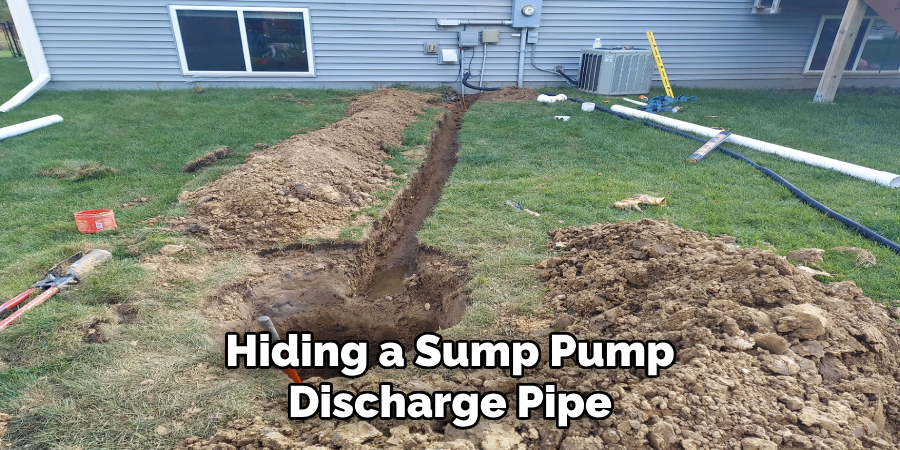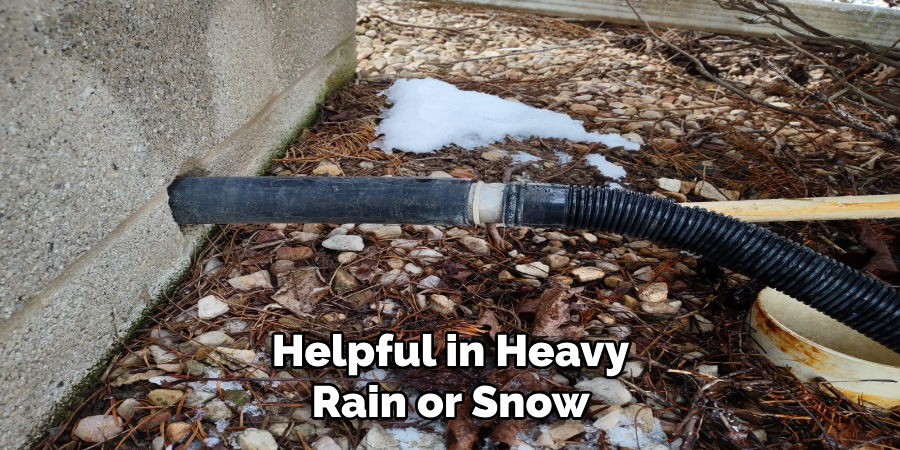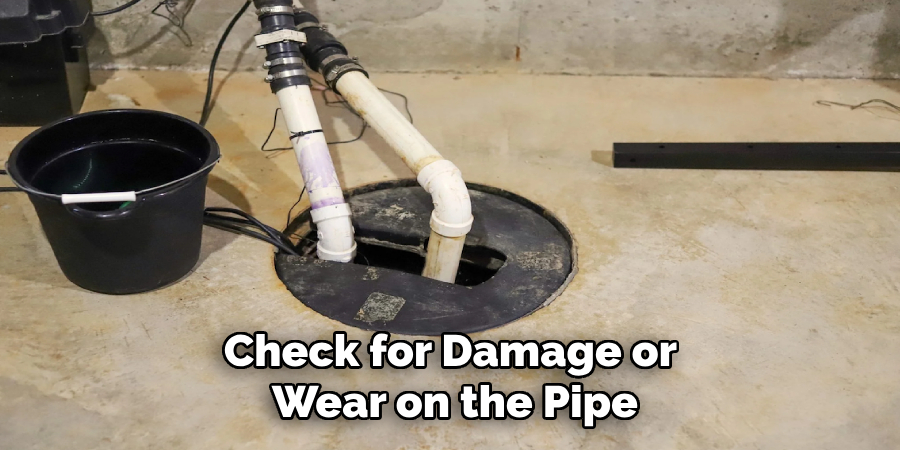A sump pump discharge pipe is essential for directing water away from your home’s foundation, preventing flooding and water damage. However, these pipes can sometimes be an eyesore, disrupting the overall aesthetic of your yard or property. Fortunately, there are several effective ways to hide or disguise sump pump discharge pipes without compromising their function. This guide will provide you with how to hide sump pump discharge pipe.

Understanding the Sump Pump Discharge Pipe
The sump pump discharge pipe plays a critical role in protecting your home from water damage by channeling excess water away from the foundation. This pipe is connected to the sump pump system, which collects groundwater or excess rainwater and pumps it out to a designated drainage area. It must be positioned and installed correctly to ensure proper water flow and minimize the risk of backups or blockages.
Typically made of durable materials like PVC, the discharge pipe is built to withstand constant exposure to water and environmental elements. Understanding its function and placement is key when considering ways to conceal it effectively while maintaining optimal performance.
Factors to Consider Before Hiding a Sump Pump Discharge Pipe
When planning to hide a sump pump discharge pipe, it is essential to take several factors into account to ensure both functionality and aesthetics are preserved. First, ensure that the pipe’s placement allows for proper drainage. The discharge pipe must direct water away from the foundation of the property to prevent flooding or water damage. Second, consider accessibility for maintenance and repairs. Even when concealed, the pipe should remain easy to access in case of clogs, leaks, or other issues.
Additionally, ensure that the materials or structures used for hiding the pipe do not obstruct water flow or compromise the durability of the pipe. Lastly, be mindful of local building codes and regulations to guarantee the discharge system remains compliant and does not result in penalties or drainage issues for neighboring properties. Taking these factors into account will help achieve an effective balance between functionality and visual appeal.
10 Methods How to Hide Sump Pump Discharge Pipe
1. Bury the Discharge Pipe Underground
One of the most common and effective methods for hiding a sump pump discharge pipe is to bury it underground. This approach not only removes the pipe from view entirely but also helps protect it from weather and accidental damage. Begin by digging a trench at a slight downward slope (typically 1/8 inch per foot) from the pump’s outlet to the discharge point, ensuring the water will drain properly.

Use a rigid PVC pipe or durable corrugated tubing for longevity. Cover it with soil and reseed the grass for a clean, natural finish. Remember to include an outlet grate or bubbler pot where the pipe ends to prevent erosion and clogging.
2. Route the Pipe Through a Decorative Rock Bed
For a solution that blends with landscaping, consider routing the discharge pipe through a dry creek bed or decorative rock garden. This method is ideal if you already have—or plan to create—an area with stones, gravel, or mulch. Lay the pipe low within the bed and cover it loosely with rocks to allow water to drain easily while concealing the pipe.
This creates a visually appealing landscape feature that also serves a functional drainage purpose. Ensure that the water runoff from the pipe is directed away from your home’s foundation and doesn’t erode the bed’s structure.
3. Use Hollow Faux Landscaping Features
Another clever disguise involves hiding the discharge pipe inside faux landscaping objects such as artificial boulders, hollow logs, or decorative garden statues. These are available at most garden centers and online retailers. Choose a cover that matches your yard’s aesthetic and place it strategically over the section of pipe that emerges from the house or ground. Ensure that the object doesn’t obstruct the pipe’s outlet or impede water flow. This method works best for small visible sections near the house and can be combined with other camouflage techniques.
4. Plant Shrubs or Tall Ornamental Grasses
If you prefer a natural camouflage, plant fast-growing shrubs, hedges, or tall ornamental grasses along the path of the discharge pipe. These plants can effectively hide exposed piping and blend the area into the rest of your garden. Choose species that tolerate moisture well if they’ll be near the discharge outlet, such as red twig dogwood, fountain grass, or inkberry. Be careful not to plant too close to the pipe itself; roots may eventually interfere with the flow or cause damage, so maintain a buffer zone as needed.

5. Build a Wooden Cover or Box Enclosure
For a more structured and DIY-friendly solution, build a wooden box or cover around the exposed section of the discharge pipe. Use treated lumber, cedar, or composite decking materials to create a weather-resistant housing. Ventilation slats or removable lids can ensure water still flows properly while allowing for future maintenance. You can stain or paint the enclosure to match your home or deck for a seamless look. This method works well for pipes that run along the exterior wall before entering the ground.
6. Run the Pipe Along a Fence Line or Trellis
If you have a fence or trellis near the sump pump outlet, consider routing the discharge pipe along it. Secure the pipe horizontally near the base or behind decorative panels where it remains mostly out of sight. Add climbing plants like clematis or ivy to create living cover, or mount lattice panels in front of the pipe. This strategy keeps the pipe elevated, which can be helpful in heavy rain or snow, and offers an opportunity to add greenery and visual interest to your yard.
7. Paint the Pipe to Match Its Surroundings
Sometimes, the simplest disguise is a fresh coat of paint. Outdoor-rated spray paint in colors that match your siding, trim, foundation, or landscaping can help the discharge pipe visually recede. Use primer and paint designed for plastic or PVC to ensure durability and adhesion. While this won’t physically hide the pipe, it reduces its visual impact and helps it blend into the background—especially when used in combination with planting or decorative covers.
8. Extend the Pipe to a Rain Garden
Turn your sump pump discharge into an opportunity for sustainable landscaping by redirecting the pipe to a rain garden. A rain garden is a shallow, planted depression that absorbs and filters runoff using native plants and soil layers. By extending the discharge pipe underground and daylighting it at the edge of the garden, you effectively hide the pipe while managing water in an eco-friendly way. Choose plants with deep roots that tolerate periodic saturation, and design the garden to blend with your existing landscape.

9. Install a French Drain Extension
Another great way to hide the discharge pipe and improve drainage is by installing a French drain system. This consists of a gravel-filled trench containing a perforated pipe that disperses water more evenly underground. After extending the sump pump discharge ideas to the trench, cover it with landscape fabric and gravel. The surface can be left as-is or finished with soil and grass for total invisibility. French drains reduce surface runoff, prevent pooling, and completely eliminate exposed piping.
10. Incorporate the Pipe into a Landscape Feature
Think creatively and make the discharge pipe part of a larger landscape design. For example, route the pipe to feed a decorative pond or rock waterfall feature. This approach not only hides the pipe but gives it a functional and aesthetic purpose. You can direct the discharge to gently fill a low basin of stones or a small wetland area that absorbs the water naturally. Just be sure that the outlet location still complies with local codes and directs water away from your home and neighboring properties.
Maintenance and Upkeep
Regular maintenance of your discharge pipe and surrounding features is essential to ensure proper functionality and longevity. Periodically inspect the pipe for any blockages, such as debris or sediment buildup, which could restrict water flow. Clear away any obstructions promptly to prevent water from backing up into your system. If your pipe is integrated into a landscape feature like a pond or wetland area, monitor these elements to ensure they remain clean and do not overflow.
Additionally, check for damage or wear on the pipe, especially after severe weather, and repair or replace sections as needed. Proper upkeep not only ensures efficient water management but also sustains the aesthetic appeal of your design.

Conclusion
Hiding a sump pump discharge pipe is not just about aesthetics—it’s also about balancing form and function. From burying the line underground to incorporating it into beautiful garden features, each method has its advantages and requirements. Whichever approach you choose, always prioritize proper drainage and pipe access for maintenance.
By combining practical installation with thoughtful design, you can preserve your home’s protection against water while enhancing your outdoor space with creativity and care. Be sure to follow all instructions on how to hide sump pump discharge pipe carefully, and always consult an expert when in doubt.
About the Author
Adrian Green is a passionate woodworking enthusiast who has dedicated his life to the craft of woodworking. From his early days working alongside his father in the family woodworking shop, Adrian has honed his skills and developed a deep love for creating beautiful, functional pieces with his hands. As the voice behind The Woodenify Blog, he shares his knowledge, tips, and inspiration with fellow woodworkers of all skill levels, helping them build confidence in their abilities while learning new techniques.
Professional Focus
- Specializes in DIY woodworking projects, from furniture making to home décor.
- Provides step-by-step guides, tips, and practical tutorials for woodworkers at any skill level.
- Focused on empowering readers with confidence and knowledge through easy-to-follow instructions and hands-on techniques.
- Passionate about building a community where makers can share, learn, and grow together in the world of woodworking.
Education History
University of Craft and Design – Bachelor of Fine Arts (BFA) in Woodworking and Furniture Design
Woodworking Apprenticeships – Gained extensive hands-on experience through various workshops and mentorships with seasoned craftsmen, refining carpentry and furniture-making skills.
Expertise
- DIY woodworking, carpentry, furniture making, and home décor projects.
- Creating clear, accessible tutorials and guides for beginner to advanced woodworkers.
- Helping readers experience the satisfaction and fulfillment of turning raw materials into stunning finished products.
